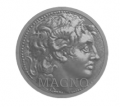Projects
Current Projects

JOINT ACTION TOWARDS DIGITAL TRANSFORMATION (JANO-FA)
JANO-FA aims to develop a new generation of materials for extreme environments which are able to withstand high temperatures and […]
Superalloys for additive manufacturing (SAM)
SAM aims to improve the printability of high temperature alloys for additive manufacturing by overcoming the main technical hurdles that […]

Smart fabrication of advanced materials for transport, energy and health (MAT 4.0)
MAT4.0 aims at creating an innovation hub in the area of Smart Manufacturing of advanced materials for energy, transport and […]

Improvement of the 3D Metal Jet part quality through print mode development supported by HR-XCT characterization of the printed parts (METALJET)
METALJET aims to understand the relationship between the 3D printing parameters, the microstructure, and the properties of steel components fabricated […]

ENUSA_MECHANICAL STRENGTH OF EXPANDED UNIONS
ENUSA INDUSTRIAS AVANZANDAS, S.A., S.M.E. (ENUSA) is a public enterprise 60% owned by the Sociedad Estatal de Participaciones Industriales (SEPI), an […]
ULTRAFINE EUTECTICS BY LASER ADDITIVE MANUFACTURING (ELAM)
The proposed project aims at developing new high strength eutectic alloys by laser-based additive layer manufacturing (ALM) using selective laser […]

INNOVATIVE AL ALLOY FOR AIRCRAFT STRUCTURAL PARTS USING ADDITIVE MANUFACTURING TECHNOLOGY (ALFORAMA) (#755610)
The main goal of the AlForAMA project is to develop an innovative high strength Al alloy suitable for Selective Laser […]
Completed Projects

THE HIGH TEMPERATURE FATIGUE BEHAVIOR OF A THIRD GENERATION GAMMA TIAL ALLOY FOR GREENER TURBINES (MAT2016-77189-R)
The overarching aim of the CRACKTIAL project is to gain fundamental knowledge on the influence of microstructure, defects and temperature on the monotonic and fatigue response of a 3rd generation gamma-TiAl alloy within a wide temperature range. It is foreseen that the outcome of the present project will contribute to a more efficient defect tolerant design of turbine components that can operate safely at increasingly demanding temperature and cyclic stress conditions.

UNDERSTANDING THE MICROSTRUCTURAL EVOLUTION AND DEFORMATION BEHAVIOR IN MG-MN-RE ALLOYS (MAGMAN)
The global aim of this collaborative Spain-US project was to analyze the deformation, recrystallization, and damage mechanisms of several advanced Mg alloys fabricated by rare-earth alloying. Several alloys were generously donated by the Helmholtz Zentrum Geesthacht (Geesthacht, Germany) for this research. A combination of microstructure and mechanical characterization techniques were utilized to achieve the desired objective.

MULTISCALE DESIGN OF ADVANCED MATERIALS (DIMMAT)
The global objective of this proposal is to leverage the complementary capabilities of several research groups of Madrid in order to develop a design methodology for advanced materials by integrating multiscale materials modeling tools and combinatorial processing methods. We intend to develop an innovation process that is more efficient and, therefore, more economically advantageous than traditional tiral and error strategies for the discovery of new materials.

NEW METALLIC MATERIALS BY COMPRESSION AND SHEAR (FASENOVA)
Conventional strategies to process advanced metals include alloy design, thermomechanical processing, the fabrication of composites or a combination of all these. However, these methods have limitations. Many alloys present allotropic modifications with unique properties which are stable at extreme temperatures (either high or cryogenic) and/or high pressures and which can currently not be exploited.

GAMMA TITANIUM ALUMINIDES FOR HIGH RELIABILITY COMPONENTS (ALTIVA)
Gamma-titanium aluminides are an important new class of turbine engine materials because they can provide increased thrust to weight ratios and improved fuel efficiency. The aim of the ALTIVA project was to investigate the deformation and fracture mechanisms of a Ti4522XD alloy under service conditions.

PHYSICAL PROCESSING OF MOLTEN LIGHT ALLOYS UNDER THE INFLUENCE OF EXTERNAL FIELDS (EXOMET)
To find better ways of producing nano-composite materials, IMDEA Materials participates in a large scale collaborative project led by the European Space Agency with the European Commission, universities from Europe, Russia and Australia, and industrial companies such as EADS, Fiat and Volvo. This ExoMet project is under way with a €20 million investment from public and private sources.

MAGNESIUM NEW TECHNOLOGICAL OPPORTUNITIES (MAGNO)
A collaborative research project funded by the Centre for the Development of Industrial Technology (CDTI) within the fourth call of […]


